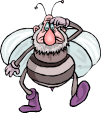 The History of Beekeeping.
The History of Beekeeping.
Why keep bees?
Historically, bees have been of interest to man for over 5,000 years mainly for the honey which they produce. It was the only natural sweetener available before the advent of commercially produced sugars from cane and beet.
Originally and still today in parts of the world it was the wild bees nests which were raided for the honey they contained. I suppose that we should call all honey bees wild since they take advantage of suitable enclosures to use as a nest. These may be a hollow tree, some form of log hive, or the more common hive now used by the modern beekeeper. Since in all cases the bees are free to come and go as they please and man removes surplus honey they are all wild but they are a managed wild creature.
Before the advent of the modern movable frame hive bees were kept in straw skeps. The space available to the bees was limited so they regularly swarmed (a natural method of colony reproduction) which served to replace the colonies which were killed to obtain the honey. The space for the bees could be enlarged by adding an extra chamber called an eke (hence the term to eke something out) and to protect the hive from the weather a straw hackle was added. This was roughly a cone shaped device to deflect the rain. Sayings such as "to eke out" and "raising the hackles" have passed into common usage.
Honey bees were maintained by religious communities in monasteries mainly for the wax they produced. From this beeswax candles were produced; these were far superior to the candles made from tallow used by the general population. A welcome addition was the honey as a sweetener and when the honey was mixed with water and allowed to ferment it produced mead, and is the probable origins of the term "merry monk". No doubt the alcohol in the mead helped stave off the cold on long dark medieval winters.
Honey bees gave sweetness and light.
There are many instances of bees and honey being referred to in the Bible and the following are just a few samples:-
 Download Membership form
Download Membership form